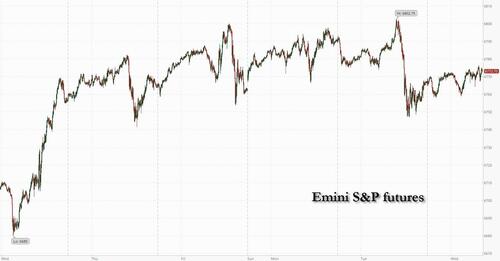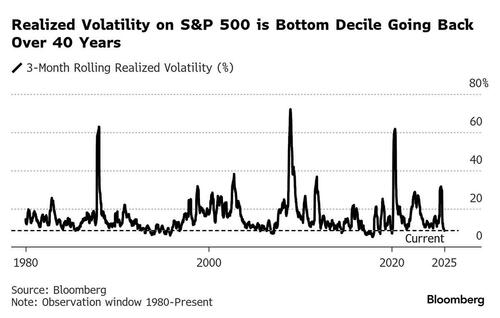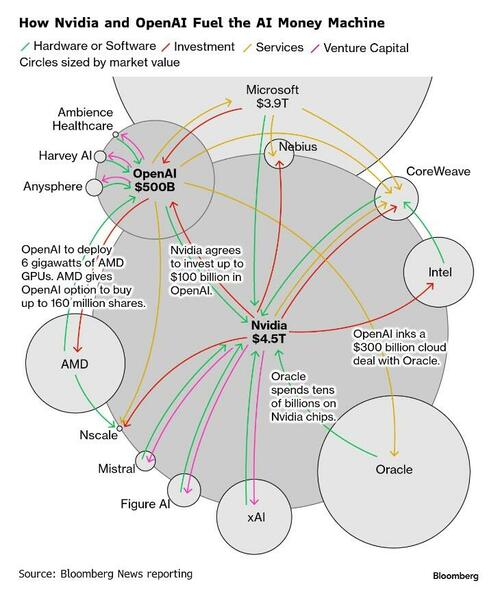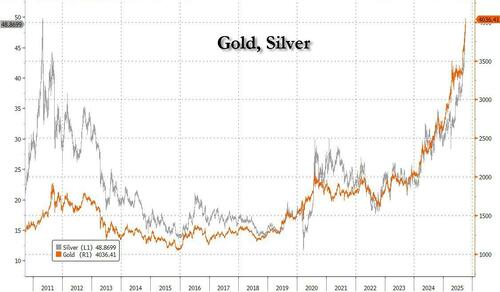

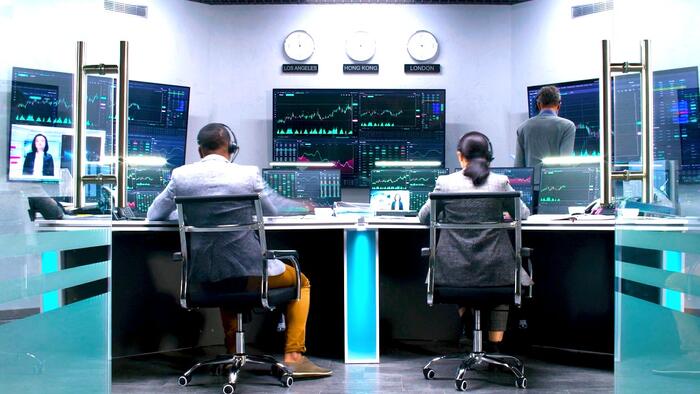
Futures are higher again, reversing Tuesday's modest Oracle-led decline, and are led by small caps despite additional multi billion tech investment headlines. As of 8:00am ET, S&P 500 futures were 0.1% higher, set for their 8th gain in the past 9 days, with Nasdaq 100 contacts +0.2% with Mag7, Semis, and AI-themed plays all rallying off the investment news. In premarket trading, AMD extended gains after an explosive rally following its multibillion-dollar AI deal with OpenAI. Tesla advanced after it unveiled a cheaper version of its top-selling electric vehicle. Cyclicals poised to outperform Defensive even as Ray Dalio warned that the AI-driven market rally “feels frothy.” Of course, it is all now just a debasement trade with everyone and their mother dumping fiat and buying hard currencies, sending gold above $4,000 an ounce for the first time, and silver above $49. The dollar gained for a third day against major peers and is now 2.5% off its 52-wk low as 96.00, while Treasury yields dipped. In commodities, Energy and Precious metals are the stand outs as gold breaks above $4k. The Administration said ~$13bn in farming aid may be rolled out soon. Today we get the FOMC minutes at 2pm; the Federal Budget Balance will likely be delayed due to the government shutdown.
In premarket trading, Mag 7 stocks are mixed (Tesla +0.3%, Nvidia +0.6%, Amazon +0.4%, Microsoft +0.1%, Meta Platforms -0.1%, Alphabet -0.1%, Apple -0.1%).
In corporate news, Salesforce told customers it won’t pay a ransom demand from a hacker who claimed to have stolen a large amount of client data and threatened to publish it. xAI is raising more financing than initially planned, tapping backers including Nvidia to lift its ongoing funding round to $20 billion, according to people with knowledge of the matter.
Concerns have been growing that $16 trillion surge in the S&P 500 from its April lows had gone too far. Tuesday’s drop came amid mounting chatter about lofty valuations around artificial intelligence, with some market participants seeing an echo of the excesses that led to the dot-com crash 25 years ago. On Tuesday, investors turned cautious after the Information reported that Oracle may post a disappointing profit margin for the latest quarter, spurring a selloff in tech shares. Still, many investors fear missing out on further gains, with the upcoming earnings season set to provide clues on the rally’s sustainability.
“There are worrying signals on the AI rally, which reminds me of 1997 when I started my career,” said Gilles Guibout, head of European equities at Axa Investment Managers. “The bubble burst in 2000 but those managers who had refused to follow the rally, rightfully expecting it to go pop, lost a lot of money for their clients. There’s a real risk to get out of the AI trade too early; what you need to do is stay invested but with your finger on the exit button and stay diversified.”
And with nobody willing to sell first, equity volatility remains deeply subdued, despite a growing list of potential cracks beneath the surface. According to Bank of America, S&P 500 three-month realized vol sits near 8.5%, its lowest decile since 1990.
Catching up to our discussion on the massive AI circle jerk, Bloomberg’s Big Take today highlights how a wave of deals involving Nvidia and OpenAI are escalating concerns that an increasingly complex and interconnected web of business transactions is artificially propping up the AI boom. Still, Goldman strategist Peter Oppenheimer said it’s too early to be worried about a bubble. The rally in tech has been accompanied by robust earnings growth, while previous bubbles were driven mainly by speculation. And Jamie Dimon said that JPMorgan’s investments in AI are paying off, with cost savings matching the $2 billion annual spend on developing the technology.
As noted last night, the global currency debasement trade pushed Gold above $4,000 an ounce for the first time ever, with silver rising above $49 for the first time since 2011 and on pace for a new record high.
Europe’s Stoxx 600 benchmark climbed 0.6%, on track for another record close, as the basic resources sector jumped more than 1%. The French CAC 40 outperformed most of its regional peers after the outgoing PM expressed optimism that an accord can be reached to allow the formation of a new government. Lloyds Banking Group Plc led banks higher after a favorable ruling on the cost of disputed car loans. European stocks were also buoyed by moves to resolve France’s budget impasse. The country’s CAC 40 equity index rose as much as 0.8% and bond yields fell. The European technology sub-index, however, underperformed. BMW AG slumped, dragging peers lower, after the German luxury-car maker cut its financial guidance on weak sales in China and tariff-related costs. Here are some of the biggest European movers today:
Meanwhile, the US / EU trade deal is being questioned by the EU as the US makes new demands, calling into question the Trump / Van Der Leyen agreement.
Earlier in the session, Asian stocks declined, driven by losses in technology shares on fresh concerns over the justification for the artificial intelligence boom. The MSCI Asia Pacific Index fell as much 0.8%, the most since Sept. 26, with TSMC, Alibaba and SoftBank among the biggest drags. Hong Kong led losses as the market reopened after a holiday, while Taiwan, Singapore and Malaysia also saw declines. Vietnam’s benchmark briefly surged as much as 3% before paring much of the gain, after FTSE Russell upgraded it to emerging market status from frontier. Elsewhere, New Zealand’s key stock index extended gains after the central bank cut interest rates more aggressively than expected and said it’s open to further reductions. Traders also await a decision in Thailand, where the central bank is expected to deliver its fourth interest rate cut of the year.
In FX, the euro falls 0.3% amid a broad dollar rally. The kiwi is one of the weakest of the G-10 currencies, falling 0.6% after the RBNZ cut interest rates by 50 bps.
In rates, Treasuries bull-flattened in the early US session with long-end yields richer by around 2.5bp on the day, following similar price action in European bonds. With US front-end yields little changed, 2s10s and 5s30s spreads are flatter by 2bp-3bp; 10-year near 4.1% is 2bp lower on the day, with UK’s keeping pace and Germany’s outperforming after auctions in both markets. French bonds advanced during London morning after caretaker prime minister struck a note of optimism on the budget before starting a final day of talks to form a government, narrowing the 10-year French yield spread with Germany by 3 bps to around 83 bps. US session includes 10-year note auction and minutes of September FOMC meeting.
In commodities, gold is up over $50, having crossed $4,000/oz for the first time earlier today. WTI crude futures rise 1% to $62.30 a barrel.
The US economic calendar calendar, still subject to delays from the ongoing government shutdown, includes FOMC meetings minutes release at 2pm. Fed speaker slate includes Musalem (9:20am), Barr (9:30am, 5:45pm), Goolsbee (10am, 7:15pm) and Kashkari (3:15pm, 4:30pm)
Market Snapshot
Top Overnight News
Trade/Tariffs
A more detailed look at global markets courtesy of Newsquawk
APAC stocks traded mixed with demand hampered following the negative handover from the US, where stocks snapped a 7-day win streak as small caps underperformed and with sentiment weighed on by AI-profitability concerns. ASX 200 was rangebound as gains in healthcare and the top-weighted financial industry were offset by underperformance in Tech and Consumer sectors. Nikkei 225 lacked conviction and oscillated around the 48,000 level amid a weaker currency and soft wages data. Hang Seng retreated on return from the holiday closure with tech stocks heavily represented in the list of worst performers, while mainland participants were still away but are set to return from the National Day Golden Week celebrations tomorrow.
Top Asian News
Top European News
FX
Fixed Income
Commodities
Geopolitics: Middle East
Geopolitics: Ukraine
US Event Calendar
Central Banks
DB's Jim Reid concludes the overnight wrap
Markets struggled to gain traction yesterday, posting a risk-off move as investors grappled with political uncertainty in France and the US government shutdown. So the S&P 500 (-0.38%) lost ground from its record high on Monday, and 10yr Treasury yields (-2.9bps) also fell back. That concern was clear on several fronts, and investor jitters about France’s debt trajectory pushed the Franco-German 10yr spread to 86bps, the biggest gap since January. Moreover, spot gold prices have just risen above the $4,000/oz mark for the first time overnight, continuing its relentless rally that’s seen it rise more than 50% so far this year.
In terms of the latest from France, there’s been little sign of any progress being made following PM Lecornu’s resignation on Monday. As a reminder, President Macron gave Lecornu a deadline of tonight to reach agreement among the different political groups, but so far at least there’s been no compromise emerging. Indeed, yesterday there was mounting speculation about another legislative election being called. For instance on Polymarket, it’s suggesting there’s a 67% chance of another election being called, rather than a new PM being appointed, which is up from 49% as we went to press yesterday. And at one point yesterday evening, it even rose as high as 85%.
When it comes to the market reaction, French bonds have continued to underperform, pushing the 10yr spread over bunds up to 86bps. So that’s very close to its peak of 88bps last December when it became clear that former PM Michel Barnier was likely to lose the confidence vote. Indeed, that 88bps level hasn’t been exceeded since 2012, back when then-ECB President Mario Draghi pledged to do “whatever it takes” to save the euro, leading to a big confidence boost that helped spreads come down. To be fair, French equities fared relatively better yesterday, and France’s CAC 40 (+0.04%) stabilised after its Monday slump. However, banks continued to lose ground, including Société Générale (-1.88%), BNP Paribas (-1.15%) Crédit Agricole (-0.21%).
Of course, politics are very much in the spotlight elsewhere, as the US government shutdown shows no sign of ending. In terms of the latest, House Democratic leader Hakeem Jeffries said that proposals to extend the Affordable Care Act tax credits for a year were “a non-starter”. Meanwhile, Republican Senator Susan Collins of Maine told reporters on Monday that she was working on a plan to reopen the government, at least partially, in exchange for a deadline for a discussion on ACA subsidies. But the bigger picture is still concern about an extended shutdown that starts to have a more meaningful economic impact, and on Polymarket, there’s only a 25% chance given to the shutdown ending before October 15.
US equities struggled against that backdrop, and the S&P 500 (-0.38%) fell back after a run of 7 consecutive gains. In part, that was driven by a decline for Oracle (-2.52%), after a report from The Information said that their profit margins for cloud computing were lower than analysts’ estimates. So tech stocks struggled, and the Magnificent 7 (-1.25%) and the NASDAQ (-0.67%) also saw a decent decline. Autos (-4.37%) were the biggest laggard in the S&P, as Tesla (-4.45%) fell after their announcement of a less expensive version of their model Y car and Ford fell -6.1% after the WSJ reported that a plant fire in a New York state aluminum plant will increase costs and cause delivery disruptions. Meanwhile, the outperformers were among the more defensive sectors, with consumer staples (+0.86%) and utilities (+0.42%) both advancing.
As that was happening, Treasury yields fell across the curve, with the 10yr yield coming down -2.9bps on the day to 4.12%. That came as investors slightly dialled up the pace of Fed rate cuts over the months ahead, with 111bps priced in by December 2026, up +2.0bps on the day. Meanwhile, Fed speakers continued to strike a divergent tone. For instance, Fed Governor Miran remained dovish, saying that he was “more sanguine on the inflation outlook than a lot of other people are”. But Minneapolis Fed President Kashkari warned that “Some of the data that we’re looking at is sending some stagflationary signals”.
On that theme, the New York Fed’s latest Survey of Consumer Expectations found that near-term inflation expectations ticked higher in September. So 1yr inflation expectations ticked up to 3.4%, which is their highest since April, and 5yr expectations moved up to 3.0%, which is their highest since February. However, it’s still an open question what will happen with the US CPI report itself on October 15, as it’s a release that will also be affected by the ongoing government shutdown, just like payrolls was last Friday.
Back in Europe, there wasn’t too much happening outside of France, with most assets seeing little change. So the STOXX 600 (-0.17%) only posted a modest decline, alongside steady moves for the DAX (+0.03%) and the FTSE 100 (+0.05%). Similarly for bond yields, there wasn’t too much movement in absolute terms, with yields on 10yr bunds (-1.0bps), OATs (+0.3bps) and BTPs (-0.4bps) seeing little change. There also wasn’t much data, although German factory orders underwhelmed with a -0.8% decline in August (vs. +1.2% expected).
Overnight in Asia, things have been a bit more eventful this morning, with continued movements in Japanese markets after Sanae Takaichi’s election as LDP leader. For instance, the 10yr government bond yield (+1.4bps) has reached a post-2008 high of 1.69%, whilst the yen (-0.30%) has weakened overnight to 152.36 per dollar, its weakest level since February. Meanwhile, the Nikkei (-0.11%) has also lost ground after a run of 4 consecutive gains. That comes as data showed wage growth was softer than expected in August, with nominal wages up +1.5% year-on-year in August (vs. +2.7% expected). And in real terms, wage growth remains negative as it has throughout 2025, at -1.4% (vs. -0.5% expected). Otherwise, there’s been a mixed equity performance in Asia, with the Hang Seng (-1.07%) losing ground, alongside gains for the CSI 300 (+0.45%), the Shanghai Comp (+0.52%) and the KOSPI (+2.70%).
Elsewhere, the main surprise has come from New Zealand overnight, where the Reserve Bank of New Zealand delivered a surprise 50bp cut, larger than the 25bp move expected, which takes their Official Cash rate down to 2.5%. So that’s led to a depreciation in the New Zealand dollar, which has weakened by -0.96% against the US dollar overnight, making it the worst-performing G10 currency. The statement said that the committee “remains open to further reductions”, and New Zealand’s 10yr yield (-4.6bps) has fallen to a 12-month low in response.
Finally, the other big headline overnight has been that spot gold prices have risen through the $4,000/oz mark for the first time. The latest moves come with treasury yields moving lower and the ongoing shutdown, but gold prices have been moving higher throughout the year, having risen by more than +50% since the end of 2024. So as it stands, it remains well on track for its strong annual increase since 1979, when the oil shock that year led to a huge surge in inflation. As a reminder, Marion on our team published an update yesterday (link here) on the future of central banks holding both gold and Bitcoin in their balance sheets by 2030.

